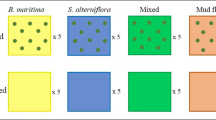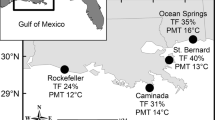Abstract
Mangrove reforestation projects often suffer from low sapling survival, especially after transplanting saplings from nurseries to reforestation areas. This may be due to the sediment conditions at the target site, the planting strategy or failure to re-establish ecosystem processes. We examined experimentally the influence of environmental context, species richness and identity, sapling height and position on sapling survival and environmental variables linked to ecosystem functioning at deforested sites in Gazi Bay, Kenya. At site 1, a high shore location, 32 plots (36 m2) were planted with 8 treatments: all possible combinations of Avicennia marina, Bruguiera gymnorrhiza, and Ceriops tagal and an unplanted control (total: 3390 saplings; 4 plots/treatment). At site 2, a low shore location, the influence of sapling height, sapling position and sediment depth were tested by planting with 697 Sonneratia alba in a single monospecific plot (341 m2). After ∼2 years, there were significant differences in survival among the three species at site 1 with Bruguiera gymnorrhiza recording the lowest survival rate (29%). Survival was correlated with salinity (a strong effect) and height above chart datum (a weaker effect) at site 1. Sapling position did not significantly affect survival at either site. There was thus no evidence that early survival of transplanted saplings is influenced by the species mix in which they are grown, or by their position in the plot. Rather the tolerance of individual species to salinity was the key to their survival at the high tidal site. Species mix also had no significant effects on environmental variables in the plots. The former presence of a species at a site does not guarantee it will succeed there again if environmental degradation has exceeded species’ tolerance.



Similar content being viewed by others
References
Abuodha, P. A. W. & J. G. Kairo, 2001. Human-induced stresses on mangrove swamps along the Kenya coast. Hydrobiologia 458: 255–265.
Ball, M. C., 1988. Salinity tolerance in the mangroves Aegiceras corniculatum and Avicennia marina I. Water use in relation to growth, carbon partitioning and salt balance. Australian Journal of Plant Physiology 15: 447–464.
Ball, M. C., 2002. Interactive effects of salinity and irradiance on growth: implications for mangrove forest structure along salinity gradients. Trees 16: 126–139.
Bertness, M. D. & S. D. Hacker, 1994. Physical stress and positive associations among plants. American Naturalist 144: 363–372.
Bosire, J. O., F. Dahdouh-Guebas, J. G. Kairo & N. Koedam, 2003. Colonization of non-planted mangrove species into restored mangrove stands in Gazi bay, Kenya. Aquatic Botany 76: 267–279.
Bosire, J. O., 2006. Ecological recovery of reforested mangroves in Kenya. Unpublished Ph.D. Dissertation, APNA, Belgium. Free University of Brussels.
Cardona-Olarte, P., R. R. Twilley, K. W. Krauss & V. Rivera-Monroy, 2006. Responses of neotropical mangrove seedlings grown in monoculture and mixed culture under treatments of hydroperiods and salinity. Hydrobiologia 569: 325–341.
Cintron-Molero, G., 1992. Restoring mangrove systems. In Thayer G. W. (ed.) Restoring the Nation’s Marine Environment. Maryland sea grant program, College Park, 223–277.
Clarke, P. J., R. A. Kerrigan & C. J. Westphal, 2001. Dispersal potential and early growth in 14 tropical mangroves: do early life history traits correlate with patterns of adult distribution? Journal of Ecology 89: 648–659.
Collet, D., 1994. Modelling Survival Data in Medical Research. Chapman and Hall, London.
Dahdouh-Guebas, F., C. Mathenge, J. G. Kairo & N. Koedam, 2000. Utilization of mangrove products around Mida creek (Kenya) amongst subsistence and commercial users. Economic Botany 54: 508–522.
Eleftheriou, A. & A. McIntyre, 2005. Methods for the Study of Marine Benthos. Blackwell Science, Oxford. U.K.
Elster, C., 2000. Reasons for reforestation success and failure with three mangrove species in Colombia. Forest Ecology and Management 131: 201–214.
Ewel, K. C., R. R. Twilley & J. E. Ong, 1998. Biodiversity and function of mangrove ecosystems. Global Ecology and Biogeography Letters 7: 83–94.
Food and Agriculture Organization, 2003. Status and Trends in Mangrove Area Extent Worldwide. Forest Resources Assessment Working paper 63. Food and Agriculture Organization of the United Nations, Rome.
Gascon, C., G. B. Williamson & G. A. B. da Fonseca, 2000. Receding forest edges and vanishing reserves. Science 288: 1356–1358.
Kairo, J. G., 1995. Community participatory forestry for rehabilitation of deforested mangrove areas of Gazi bay (Kenya). A first approach. Final technical report. WWF-US and University of Nairobi.
Kairo, J. G., F. Dahdouh-Guebas, J. Bosire & N. Koedam, 2001. Restoration and management of mangrove systems—A lesson for and from the East African region. South African Journal of Botany 67: 383–389.
Kelty, M. J., 2006. The role of species mixture in plantation forestry. Forest Ecology and Management 233: 195–204.
Krauss, K. W. & J. A. Allen, 2003. Factors influencing the regeneration of the mangrove Bruguiera gymnorrhiza (L.) Lamk. on a tropical Pacific island. Forest Ecology and Management 176: 49–60.
Laurance, W. F. & E. Yensen, 1991. Predicting the impacts of edge effects in fragmented habitats. Biological Conservation 55: 77–92.
Lewis, R., 2005. Ecological engineering for successful management and restoration of mangrove forests. Ecological Engineering 24: 413–418.
Lopez-Hoffman, L., J. L. De Noyer, I. E. Monroe, R. Shaftel, N. P. R. Anten, M. Martınez-Ramos & D. D. Ackerly, 2006. Mangrove seedling net photosynthesis, growth, and survivorship are interactively affected by salinity and light. Biotropica 38: 606–616.
McGuiness, K. A., 1997. Dispersal, establishment and survival of Ceriops tagal propagules in a north Australian mangrove forest. Oecologia 109: 80–87.
McKee, K. L., 1995. Seedling recruitment patterns in a Belizean mangrove forest: effects of establishment ability and physico-chemical factors. Oecologia 101: 334–345.
Medina, E, M. Francisco, 1997. Osmolarity and d13C of leaf tissue of mangrove species from environments of contrasting rainfall and salinity. Estuarine, Coastal and Shelf Science 45: 337–344.
Minchinton, T. E., 2001. Canopy and substratum heterogeneity influence recruitment of the mangrove Avicennia marina. Journal of Ecology 89: 888–902.
Minchinton, T. E., 2006. Consequences of pre-dispersal damage by insects for the dispersal and recruitment of mangroves. Oecologia 148: 70–80.
Minchinton, T. E & M. Dalby-Ball, 2001. Frugivory by insects on mangrove propagules: effects on the early life history of Avicennia marina. Oecologia 129: 243–252.
Naeem, S., S. P. Thompson, J. Lawler, H. Lawton & R. M. Woodfin, 1994. Declining biodiversity can alter the performance of ecosystems. Nature 368: 734–736.
Naidoo, G., 1990. Effects of nitrate, ammonium and salinity on growth of the mangrove Bruguiera gymnorrhiza (L.) Lam. Aquatic Botany 38: 209–219.
Parrotta, J. A., 1999. Productivity, nutrient cycling and succession in single and mixed species stand of Casuarina equesitifolia, Eucalyptus robusta and Leucaenia leucocephala in Puerto Rico. Forest Ecology and Management 124: 45–77.
Rabinowitz, D., 1978. Mortality and initial propagule size in mangrove seedling in Panama. Journal of Ecology 66: 45–51.
Robertson, A. I., R. Giddons & T. J. Smith, 1990. Seed predation by insects in tropical mangrove forests: extent and effects on seed viability and the growth of seedlings. Oecologia 83: 213–219.
Saintilan, N., 1998. Relationships between height and girth of mangroves and soil-water conditions in the Mary and Hawkesbury river estuaries, eastern Australia. Australian Journal of Ecology 23: 322–328.
Saunders, D. A., R. J. Hobbs & C. R. Margules, 1990. Biological consequences of ecosystem fragmentation: a review. Conservation Biology 51: 18–32.
Scherer-Lorenzen, M., C. Potvin, J. Koricheva, B. Schmid, A. Hector, Z. Bornik, G. Reynolds, & E.-D. Schulze, 2005. The design of experimental tree plantations for functional biodiversity research. In: Scherer-Lorenzen, M., C. Körner, & E-D. Schulze (eds), Forest Diversity and Function: Temperate and Boreal Systems. Vol. 176. Springer-Verlag, Berlin, 347–376.
Smith, T. J. III, 1987. Effects of light and intertidal position on seedling survival and growth in tropical tidal forest. Journal of Experimental Marine Biological Ecology 110: 133–146.
Sousa, W. P., P. G. Kennedy & B. J. Mitchell, 2003. Propagule size and predispersal damage by insects affect establishment and early growth of mangrove seedlings. Oecologia 135: 564–575.
Tack, J. F. & P. Polk, 1999. Tropical catchments, their interaction with the coastal zone. In Harper D. & T. Brown (eds), Sustainable Management in Tropical Catchments. John Wiley and Sons Ltd., London.
Tilman, D., J. Knops, D. Wedin & P. Reich, 2002. Plant diversity and composition: effects on productivity and nutrient dynamics of experimental grasslands In S. Naeem, M. Loreau, & P. Inchausti (eds), Biodiversity and Ecosystem Functioning, Synthesis and Perspectives. Oxford University Press.
Toledo, G., A. Rojas & Y. Bashan, 2001. Monitoring of black mangroves restoration with nursery-reared seedlings on arid coastal lagoon. Hydrobiologia 444: 101–109.
Tomlinson, C. B., 1986. The Botany of Mangroves. Cambridge Tropical Biology Series, Cambridge, University Press, New York.
Wakushima, S., S. Kuraishi & N. Sakurai, 1994a. Soil salinity and pH in Japanese mangrove forests and growth of cultivated mangrove plants in different soil conditions. Journal of Plant Research. 107: 39–46.
Wakushima, S., S. Kuraishi, N. Sakurai, K. Supappibul & S. Somkid, 1994b. Stable soil pH of Thai mangroves in dry and rainy seasons and its relation to zonal distribution of mangroves. Journal of Plant Research. 107: 47–52.
Watson, J. G., 1928. Mangrove Forest of Malay Peninsula. Fraser and Neave, Malayan Forest Records, Vol. 6. 275. Singapore.
Yong, Y., N. F. Tam, C. Lu & Y. Wong, 2005. Effects of salinity on germination, seedling growth and physiology of three salt-secreting mangrove species. Aquatic Botany 83: 193–205.
Zedler, J. B., J. C. Callaway & G. Sullivan, 2001. Declining biodiversity: Why species matter and how their functions might be restored in Californian tidal marshes. Bioscience 51: 1005–1017.
Acknowledgements
This study is a part of a wider on-going study titled “Biodiversity and ecosystem functions in mangroves” supported by the Earthwatch Institute, the Leverhulme Trust and the Western Indian Ocean Marine Science Association (WIOMSA) to whom we are grateful. We also extend our gratitude to the Gazi field station of the Kenya Marine and Fisheries Research Institute (KMFRI) and, finally, thanks to the 2 anonymous reviewers as well as the editor for their important comments which went a long way to improving the article. The lead author is a doctorate student at Napier University, Scotland.
Author information
Authors and Affiliations
Corresponding author
Additional information
Handling editor: T. P. Crowe
Rights and permissions
About this article
Cite this article
Kirui, B.Y.K., Huxham, M., Kairo, J. et al. Influence of species richness and environmental context on early survival of replanted mangroves at Gazi bay, Kenya. Hydrobiologia 603, 171–181 (2008). https://doi.org/10.1007/s10750-007-9270-3
Received:
Revised:
Accepted:
Published:
Issue Date:
DOI: https://doi.org/10.1007/s10750-007-9270-3




